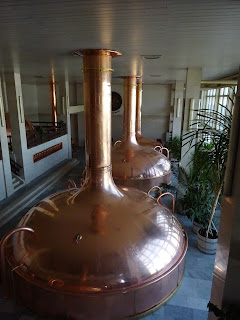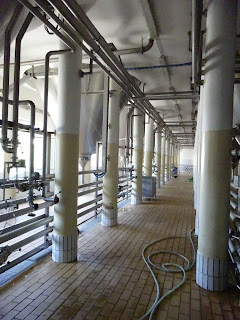Last stop on the study tour was Budějovický Budvar or the Budweiser Budvar brewery. As someone who drinks in the ways of righteousness I've never been much a lager drinker and I've always preferred Pilsner Urquell to Budweiser Budvar. But our mother church did
campaign to keep it independent and it is a fascinating brewery. Ninety days lagering! Bonkers I tell you.
The head brewer was there to meet us and show half the group round. He said we could take any pictures and they have no secrets, "what we do is in the text books".
The brewery was built in 1895 on the road to Prague above a good water supply. We passed a couple of massive water tanks and when I asked how big they are some wit piped up "πr2h" but failed to provide a tape measure so I remained ignorant.
Actually the brewer showing us round did tell us and my ignorance is due to me getting lost somewhere in the explanation. They're definitely big though. They remove iron and manganese from the water by aerating it and whirlpooling it in the water tanks, which is a new one on me. I did a lot of work on brewing water a few jobs back but I'd never come across this. It does leave a sludge so every couple of years they have to drain the tanks to remove it.
 |
| The 300m deep well |
With annual production at 1.8 million hl a year and growing they're reaching the limits of the water supply. The water to beer ratio is 4.5-4.6: 1 and they're trying to get it down to 4:1.
The had an automated warehouse built seven years ago and it's decoration is based on the Czech flag apparently. Maybe if you squint enough you can see it.
Unsurprisingly there are lots of big tanks ...
... and gleaming copper!
It's copper cladding over stainless steel. But still, an absolutely stunning brewhouse.
They weren't brewing when we were there but normally do 12 brews a day with two sets of vessels. A third set is being planned. They do double decoction mashes and you can consult a brewing text book for more details. Oh alright, decoction mashing is a primitive European way of brewing that was developed before the invention of the thermometer. By mashing in at blood temperature and removing and boiling a portion of the mash (typically a third) before re-mixing it with the rest of the mash the temperature is raised in stages which hit the optimum temperature for the action of different enzymes (proteases, beta-glucanases and amylases) needed to get starch from poorly modified malt broken down into fermentable sugars. It does have the additional benefit of driving off the unpleasantly flavoured DMS (dimethyl sulphide) which plagues many lagers.
There are four brewing vessels per brew stream: Mash Conversion Vessel, Mash Kettle, Lauter Tun and Wort Kettle. The have a hop separator (screw and screens) before whirlpooling. Spent hops are mixed in with the spent grains and go to farmers. The brew length is 600hl.
 |
| Your chance to improve your knowledge of Czech brewing terms |
For Budweiser Budvar it's 10 tonnes of lager malt and approximately 120kg of whole cone Saaz/Žatec hops which are added by hand. So it's a SMaSH (Single Malt and Single Hop) beer, something I try and avoid as a professional brewer because it leaves you vulnerable to supply shortages and seasonal crop variability. They have three hop additions, at start of lautering, at start of boil and near the end of the boil.
The beer has a colour of 10 EBC and though (apart from the hop additions) the brewhouse is highly automated they still run wort through the taps at times as it adds 1 EBC of colour due to oxidation. They don't believe in hot side aeration problems! The bitterness is 22 IBU.
They collect the wort at 7°C and it rises to 12°C during fermentation, which takes 10 days for 10°P (1.040) beers and 12 days for 12°P (1.048) beers.
Budweiser Budvar, which makes up 80% of production, is matured for 90 days at 0-3°C so they have 300,000 hl of maturation capacity. Amongst other things they've got the 90 days maturation written into the
PGI (Protected Geographical Indication) which will surely prevent anyone trying to brew a Budweiser elsewhere.
Our hosts did deliver when we got to the maturation area.
 |
| Getting closer |
 |
| Bring on the CPD! |
 |
| Sumer is icumen in |
We had a glass of Budweiser Budvar from the tank before moving on to try some experimental beers.
 |
| The brewer showing us round brought his woolly hat for the cellars, which I'm sure those in shorts and t-shirts were jealous of. I can smugly state I'd brought a fleece. |
They had three tanks filled with beer from hop trials. One of them we were told was a cross of Saaz and Jester, which isn't physically possible what with brewing "varieties" being female plants but still, interesting all the same. We we left to help ourselves to the trial beers and at this stage I was reminded that there's always more to learn about beer. One of people in the first group managed to get separated when they left so was forced to stay with the second group until we left. I guess he was going "
full gas". Whether it was a happy accident or masterstroke I couldn't say, but it is something I'll be remembering for future brewery visits.
 |
| See the joy that doing CPD brings! |
One thing I didn't find out was why exactly a brewery mostly making a 5% ABV beer chose to make its hop trial beers which will pretty much only be drunk by brewery staff 8% ABV. A complete mystery that one.
Unlike most large breweries they still used manual flow plates instead of automated values for controlling beer/wort/yeast/cleaning fluid movements to and from tanks. This also caused us some confusion until it was pointed out to us that tanks were only used four times a year!
On the way to packaging to my surprise and delight I saw there's a brewery railway. I never even knew I had an inner train spotter.
It's the sort of thing I've only seen before in brewing history books
They use a kieselguhr filter on the beer prior to packaging. They have three bottling lines, one canning line and a keg line. The bottling lines have 108 head fillers which run at 40,000 bottles per hour.
The tunnel pasteurisers give 20-25 pasteurisation units to the beer.
Then we exited via the gift shop, and I'd enjoyed myself so much I was even tempted to buy something before I remined myself that most of my wardrobe is brewery branded clothing as it is.






































